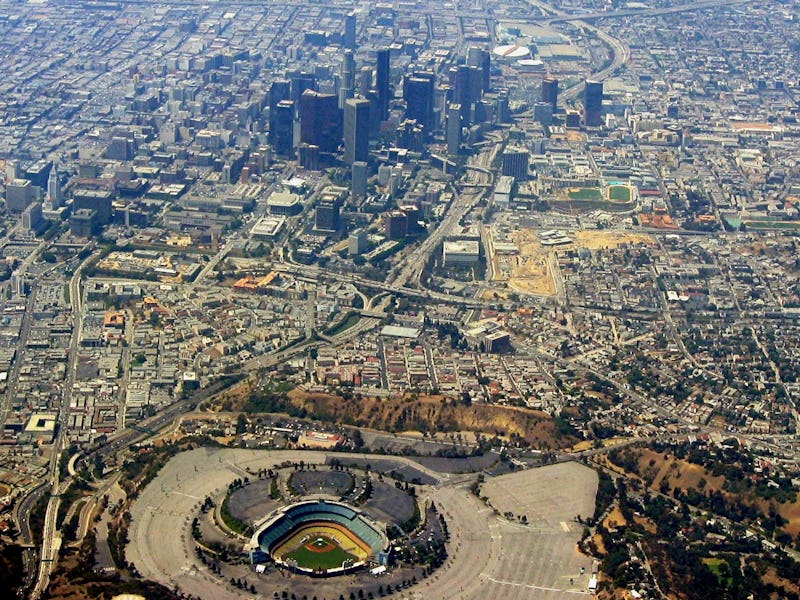The Boring Company's Dodgers Tunnel Could Help Elon Musk End LA Traffic

The Boring Company wants to take Los Angeles residents out to the ball game. On Thursday, the company unveiled proposals for the “Dugout Loop,” which would transfer baseball fans from the city’s red line out to the Dodger Stadium in less than four minutes. The plan would enable fans to watch the six-time World Series winners without dealing with the aggravation of finding a parking spot, aiding company founder Elon Musk’s plan to end Los Angeles traffic for good.
The plan would build a 3.6-mile tunnel from the stadium to one of three proposed western terminuses: near Vermont/Sunset station, near Vermont/Santa Monica station, and near Vermont/Beverly station. The terminus will be on Boring Company-owned private land, the route does not cross any metro lines, and the tunnel itself will be constructed on either public right-of-way land or private land owned or leased by the Boring Company. However, while the project is not a metro line, the company is working with the metro on project compatibility and won’t start building until the plan is approved.
It’s perhaps the first moment in The Boring Company’s less-than-two-year history that Musk will be able to make good on his promise to end Los Angeles traffic by digging tunnels. The prospect led him to declare traffic his ultimate foe:
The proposal has received a warm reception from Eric Garcetti, mayor of Los Angeles:
The plan will use the “loop” system outlined for the firm’s previous projects. These zero-emission Tesla Model X-based skates move between eight to 16 passengers at up to 150 mph, with tickets expected to cost $1 per person. Users can book ahead to buy a ticket in person, on the phone or via a mobile app. It’s expected to prove popular, transporting 1,400 people per event or around 2.5 percent of the stadium capacity, possibly doubling based on community feedback. The system is expected to transport 250,000 people each year.
Passengers load into the skate at the western terminus and a “loop lift” lowers the skate into the tunnel like so:
Boring Company Dugout Loop western terminus.
The skates would then exit at the eastern terminus:
The Boring Company eastern terminus.
Inside the tunnel, the company will use concrete shelves to guide the skates, with full illumination the whole way and six exit shafts along the tunnel. The fully-underground tunnel will be situated between 30 and 44 feet below the surface, well below the minimum 28-foot depth where residents will not feel the digging machine. Construction is set to last 14 months for the tunnel and loop lift, while the shafts will take six weeks and will be constructed at the same time as the tunnel.
The Boring Company shared maps of the Dodgers design proposals:
Dodger Stadium proposal.
It’s the latest in a series of big-scale projects for the company. The Hawthorne test tunnel, located 44 feet underground around the SpaceX campus, helped the company improve its digging technology soon after Musk announced the venture at the end of 2016. The site is where the company hosts student tours and competition winners, while it speeds up its tunnel machine to beat Musk’s pet snail that moves 14 times faster than regular machines.
The firm previously detailed plans for a 2.7-mile test tunnel under Los Angeles subject to regulatory approval, with plans to offer free public rides for a limited time. However, the Sepulveda tunnel didn’t cover passenger operations and only offered one surface terminus, so the company has decided to instead focus on the dugout project.
Beyond the test tunnels, the company has big plans for other cities. In June the city of Chicago approved plans to build a “loop” transit system from O’Hare Airport and Block 37 in downtown Chicago, up to four times faster than current transit links. A fourth tunnel would traverse the 35 miles from Washington, D.C. to Baltimore on a similar skate, with future options to extend the line to New York and convert the whole thing into a hyperloop reaching potential top speeds of 700 mph.
While The Boring Company is solving traffic woes today, in the future it could bring Musk’s vision of a vacuum-sealed pod transit system to life. Los Angeles to San Francisco in 30 minutes, anyone?